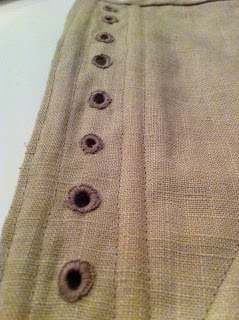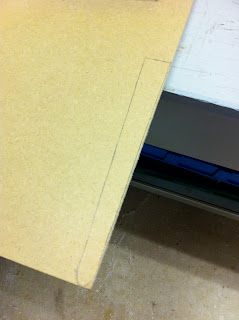Recreating the Costume of Vere Egerton
This blog will become my project diary over the next few months as I recreate the costume worn by Vere Egerton in her portrait by Robert Peake (1541-1619), for the National Trust's Dunham Massey Estate in Cheshire. Please use the tabs below to see the various stages of the project, or see below them for my most recent posts...
Apologies!
Hi Everyone!
Deepest apologies for why I've been so quiet on this blog recently! Things have been a bit hectic as I've been writing my dissertation and getting ready to move house which have unfortunatly taken me away from this project.
Please hold tight, I will be back in a few weeks time with plenty of costume updates!
Finishing the Corset....
After boning the corset (see my older posts for the previous stages in making the corset) the next stage was to attach the eyelets. I had planned on using metal eyelets, however the more I thought about it, the more I realised that if I want the re-creation of this garment to be as authentic as possible then I should really hand sew the eyelets. I have never hand sewn eyelets before, so had a quick look on the internet for how to do it, had a few practice attempts, and then got to work on the corset!
I came across a great tip when I looking for how to sew eyelets, about how to make a hole it the fabric. Instead of cutting a hole straight into the fabric, make a small puncture in the fabric, using the end of some small sharp sissors and strech out the hole out. In the picture above I am using the handle of a paint brush to stretch the holes to the required amount. This makes the holes much more stronger, as you aren't actually cutting into any of the fabric, meaning the eyelets are less likely to snag under the strain of the laces.
One down side to hand sweing the eyelets is that it obviously took alot longer than I had planned when I thought I was putting metal ones it in! However after a couple of extra days work, I am more than happy with the result, they look so much nicer than the modern metal alternative!
After I was done with the eyelets, it was time to attach the tassets and bias bind the edges....
Followed by lacing up onto the mannequin and, hurray, the corset was complete!
I am really pleased with how this corset has turned out, in particular how authentic it looks!
Shift
Hello.
I made this shift a while ago and have been meaning to do a post about it ever since. Sorry it has taken me so long!
The shift is the item of clothing that would have been worn underneath all the other layers of the garment. Worn closest to the skin, it protected the rest of the clothing from dirt and sweat.
To make mine I turned to Jean Hunnisett's Period costume for stage and screen:1500-1800: Patterns for Women's Dress, again. Although most shifts would have been made out of linen, I chose to make this one out of muslin. This is because I was finding it really hard to locate the right colour linen and then I came across this muslin in a lovely off white/cream colour which is just what I was looking for. I will also be making the ruff out of this same muslin when it comes to it so thought it would be nice for them to be made out of the same fabric, as the ruff will sit partly on the shift when compleate.
I was in a dilemma for a while about whether the shift Vere would have been wearing would have had a low neckline, the same neckline as that on the bodice, and her chest exposed. However once I looked into it, it became more apparent that the majority of shifts of the time were high neck with a small collar. This also made more sense as I looked at the portrait in more detail. What appears to be the skin on her chest seems to be more pale and even, compared to that on her face, meaning that chances are this is in fact an exposed part of the shift, not bare skin.
As for the making of the shift, it didn't take long, and as you can see from the pictures there is nothing that exciting about it! However it was the first stage in getting dressed as a Jacobean lady, or man, and was an important part of their day to day attire.
Making the Corset
Hello everyone, corset update here that I've been meaning to do for a while!
After sourcing some nice linen from Leon's Fabric shop in Chorlton, I was able to cut out the pieces fro the corset. Using the the toile pieces, which were adjusted during the fitting process, I cut double the amount of pieces out that I had done for the toile. This is because you need to make two corset shapes up, which are then attached together, forming a shell for the boning to be inserted inbetween.
Before I attached the two pieces together i needed to make and attach a pocket to the back layer of the corset for the busk. This is because, unlike the boning pieces, which are constantly attached to the corset, the busk would have been able to be removed when desired. Once this was completed, the two layers were pinned and together, very carefully, making sure all the seams were parallel to each other, so that I could begin the boning process.
Originally, corsets of this period would have been boned using whalebone, or baleen, as its also known. However, due to modern legislation surroundion the farming of whales the use of this material is corsetry is now unheard of. Most modern corsert use rigilene or steel, for more high quality corsets. I was going to use steel for this corset until I came across flat oval reed on Vena Cava's website, a well know corsetry suppliers. In their description they describe it as,
"Closely approximates the flexibility and malleability of baleen, the keratinous "feeders" of whales that came to be called "whalebone". Terrific for boning 17th, 18th and early 19th century stays."
As I'm trying to keep this corset as authentic as possible I decided to give it ago. Ever since it arrived it the post I have been over the moon with it, it is so much nicer to work with than steel and it looks so much more authentic when its in the corset.
Once the boning had arrived I was able to mark the boning channels up following the original pattern (see the second picture above) and stitch them in place. Next was to measure the length of each channel, cut a piece of boning the the required length, file the ends, cover the ends with a small amount of masking tape and the insert them into the boning channels, untill I ended up with a fully boned corset...
Just a few more steps to go now and the corset will be complete!
"Closely approximates the flexibility and malleability of baleen, the keratinous "feeders" of whales that came to be called "whalebone". Terrific for boning 17th, 18th and early 19th century stays."
As I'm trying to keep this corset as authentic as possible I decided to give it ago. Ever since it arrived it the post I have been over the moon with it, it is so much nicer to work with than steel and it looks so much more authentic when its in the corset.
Once the boning had arrived I was able to mark the boning channels up following the original pattern (see the second picture above) and stitch them in place. Next was to measure the length of each channel, cut a piece of boning the the required length, file the ends, cover the ends with a small amount of masking tape and the insert them into the boning channels, untill I ended up with a fully boned corset...
Just a few more steps to go now and the corset will be complete!
Busk
Hi there! Sorry I've been away from the blog for a couple of weeks, I've been so busy with the costume I haven't found time to write about it!
As I said in the last post I have been wanting to incorporate a wooden busk into the center front of the corset I am currently making. Although I am by no means an expert on all the functions of these busks, I do know they help the corset to create a very flat front, which looks to be the shape shown on there portrait of Vere Egerton.
After lots and lots of searching on the internet, I was really struggling to find somewhere to buy a wooden busk from, as there aren't used in modern corsetry making anymore. Even when I did find some, they would be to long for the corset I am making. However, on the brink of giving up on the busk completely, I came up with the idea of trying to make one myself. I didn't think it would be too hard as all it is, is basically a rectangular shaped piece of wood, which tapers in towards the bottom.
With this idea in mind, we took a trip to B&Q to get supplies and then we got to work. I have to admit that I had a lot of help from my boyfriend whilst making this busk because my skills at wood cutting are zero! I drew out a template for the shape of the busk in paper, which was then traced onto the wood. We used MDF wood, although defiantly not accurate to the time period, it was the most suitable wood for us to work with. After lots of sawing and sanding, all done by Matthew, with me stood next to him wincing, we finally achieved this...
The next day, after some more sanding, I dabbed some wood stain varnish onto the busk using cotton wool pads,to give it a bit more of a period look.
And here is the final product! I'm really happy with how it has turned out and quite pleased in the end that I couldn't find one to buy online!
Subscribe to:
Comments (Atom)




























